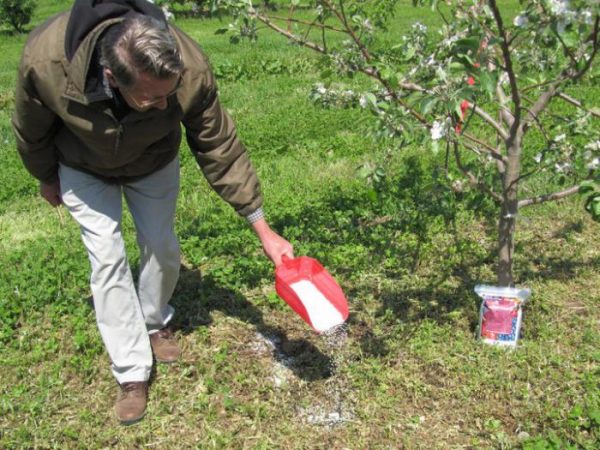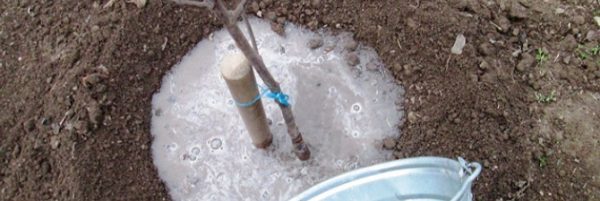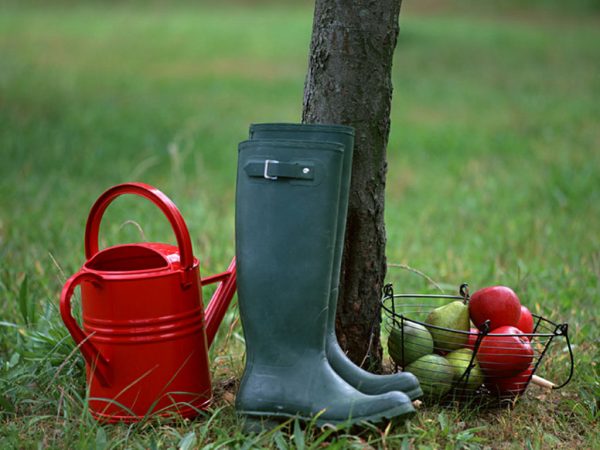How and what is the feeding of fruit trees and shrubs in spring
Content
What fertilizers to use
With the onset of warmth, growth and vegetation are activated in plants, and these processes are best carried out with the participation of nitrogen. Therefore, nitrogen-containing agents are among the first to be used for feeding the garden in early spring. Potassium and phosphorus are second in importance. They are introduced later, at the stage of intensive growth and flowering.
Important for the development of fruit trees in the spring are substances such as hydrogen, carbon, magnesium, calcium, iron, sulfur. If trees consume hydrogen and carbon from the soil, then chemical elements must be delivered to them through the introduction of complex mineral mixtures. Ready-made industrial mixtures are more effective, as they also contain many trace elements: copper, manganese, cobalt, boron in a form available to plants. From organic materials, manure of various origins (bird, cow, pork), peat, compost can be used as fertilizer in spring. Green manure crops introduced in autumn give a good effect. By the spring they completely rot and form an effective natural fertilizer. It is recommended to grow green manure on sandy and sandy loam soils, where the lack of humus is especially felt.
The first feeding with nitrogen is necessary for all fruit and berry crops without exception. For each species, you can choose the most optimal fertilizer option, but for this you need to know which plants to feed with:
- it is good to fertilize apple trees and pears with urea, humus, ammonium nitrate, droppings, after flowering it is necessary to add superphosphate, a potassium agent (potassium sulfate);
- for cherries, plums, the first top dressing in spring can consist of urea, or ammonium nitrate, during flowering - from bird droppings, at the end of flowering - from manure, compost, dry organic mixtures;
- berry bushes in the spring are fertilized with potassium nitrate, nitrophos, you can also apply ash with urea under the root (3 tablespoons of urea, 0.5 cups of ash / 10 l of water), or rotted manure with the addition of saltpeter (1 bucket of manure / handful of nitrate).
Video "Expert opinion on feeding"
Video review of the most popular top dressing for fruit trees, as well as useful fertilization tips.
What to do in March
The first feeding of fruit crops is carried out in early spring, when the snow cover has just begun to melt. During this period, nitrogen-containing agents are used - industrial mineral mixtures that stimulate the vegetative process.It is recommended to sprinkle soluble mineral fertilizers on top of the snow in the near-stem circles, which should have been well loosened in the fall. Such surface fertilization of the soil is good because melt water, penetrating into the ground, will dissolve and pull nitrogen along with it. Nitrogen agents are evenly distributed around the trunks in a radius of about 50 cm - ideally, the radius of application of top dressing is outlined by the width of the crown. It is in this zone that the largest number of root endings are located, actively absorbing useful elements. An adult tree needs 2-4 handfuls of nitrogen mixture (100-120 g), a young one needs about 40 g.
When feeding, you should pay attention to the location of the planting. If the site is located on a slope, it is better to postpone the application of top dressing, since the product can be washed away by melt water, which usually does not linger on the slopes. It is also undesirable to apply the mixture to frozen ground with a large amount of snow - in this case, the fertilizer will lie on the soil surface for a long time, due to which the nitrogen may partially evaporate.
When introducing nitrogen-containing preparations in the spring, the dosage should be observed - the principle "the more, the better" is not suitable here. Excess nitrogen in the soil can provoke fungal diseases, as well as weaken the immunity of plants. Experienced gardeners do not recommend feeding trees with complex mixtures marked "spring". In such products, as a rule, the nitrogen concentration is very high, moreover, they contain potassium and phosphorus, which should be introduced a little later.
For seedlings and young fruit trees, organic feeding with urea, liquid manure and droppings is more suitable. These fertilizers are diluted with water and applied directly to the soil under a tree or bush. When preparing an organic solution, it is recommended to adhere to the following ratio: 300 g of urea / 10 l of water, 1.5 l of liquid manure / 10 l of water, 4 l of liquid manure / 10 l of water. The approximate consumption of the solution per tree is 4-5 liters.
What to feed in April
April is the period of flowering and active formation of the deciduous part, so it's time to feed the garden trees with potassium and phosphorus. Both elements are essential for the strengthening and normal growth of trees. Phosphorus strengthens the roots, promotes their growth and consolidation in the soil. Potassium contributes to the formation of side shoots, therefore it is especially important for young trees and seedlings.
It is desirable to use these components separately, therefore complex complex mixtures containing both components are not suitable in this case. It is better to apply phosphorus fertilizer (superphosphate) in the first half of April, burying it in the soil of the root zone in close proximity to the roots. Each adult tree requires 60 g of the product, half a portion is enough for a young tree.
It is not advisable to add potassium in its pure form - it is better if it is included in simple mixtures: potassium sulfate, potassium magnesium, potassium salt, furnace ash. Potash fertilizer is applied in a dosage of 20-25 g / 1 tree.
At the end of flowering, garden trees can be pampered with organics. In April, you should definitely pay attention to feeding pears and apple trees. Many people prefer to use the so-called green fertilizer for this purpose, which must be prepared in advance, since it takes 3 weeks to ripen. The cut grass must be placed in a barrel, filled with water, the barrel must be covered with polyethylene, in which to make small holes, and insist. The finished product is diluted with water 1:10 and introduced into the root zone.
Fertilizers in May
In the last month of spring, the ovary forms and the fruit begins to grow, therefore, fruit crops must be additionally fed with organic materials: rotted manure, compost, biohumus.In the absence of organic fertilization, you can purchase a complex mixture with a slight predominance of nitrogen, which is most suitable for this type of soil. In May, fertilization can be applied in different ways:
- embed in depressions in the soil;
- dig up with the ground;
- mix with loose earth in the near-stem zone;
- mix with mulch, as well as straw, rotten leaves.
To fertilize apples and pears, you can use mineral and organic products at the same time. In mid-May, during the period of active flowering, it is necessary to feed the berry bushes - add liquid manure or urea with a small addition of saltpeter and ash under the root.May feeding with mineral mixtures can also be carried out by the foliar method. In this case, the solution for processing the crown should be slightly weaker than indicated in the instructions. It should be understood that the green part absorbs nutrients well and the trees are saturated faster, but nevertheless, root feeding is preferable, since with this method of application, trace elements remain in the soil longer.
What you need to know
When growing fruit and berry crops, you need to know what subtleties and features should be taken into account in the feeding process:
- the root system of any plant assimilates liquid subcrust better;
- young trees are not fertilized in the first year of life - seedlings should be fertilized only after complete rooting, which is achieved, as a rule, in the second year after planting;
- it is advisable to apply any product in the evening, in cloudy weather;
- dry fertilizers are best applied to wet soil, when applying dry compost, manure, the soil must be watered well - the exception is nitrogen mixtures scattered over the snow in spring;
- liquid solutions are applied only to wet soil - applying top dressing to dry soil can lead to root burns;
- in the first years of a tree's life, the effect of fertilization is less noticeable than during the period of maturation and active fruiting;
- the root system of an adult fruit tree significantly goes beyond the boundaries of the crown projection (on average by 0.5 meters);
- organic fertilizer can be applied to fertile soils not annually, but once every 2-3 years, poor soils need annual and repeated feeding;
- lime fertilizer can be applied to the soil no more often than once every 5-6 years.
Every gardener knows that getting a high yield is impossible without special dressing in the spring. Fertilizer, correctly and timely applied during the growing season, plays an important role in the further development of the plant - it increases its chances of a healthy existence and successful fruiting.
Video "Caring for fruit trees and shrubs"
Informational video about tree care, fertilization to improve fertility and pest control.







